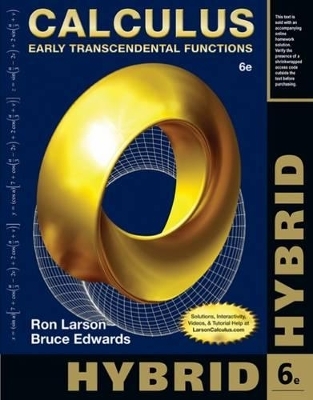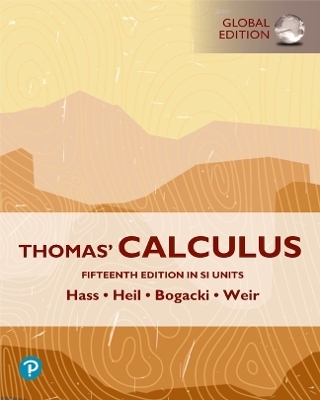
Calculus, Hybrid
Brooks/Cole
978-1-285-77702-3 (ISBN)
- Titel ist leider vergriffen;
keine Neuauflage - Artikel merken
Reflecting Cengage Learning's commitment to offering flexible teaching solutions and value for students and instructors, these new hybrid versions feature the instructional presentation found in the printed text while delivering end-of-section exercises online in Enhanced WebAssign(R). The result-a briefer printed text that engages students online! Designed for the three-semester engineering calculus course, CALCULUS: EARLY TRANSCENDENTAL FUNCTIONS, Sixth Edition, continues to offer instructors and students innovative teaching and learning resources. The Larson team always has two main objectives for text revisions: to develop precise, readable materials for students that clearly define and demonstrate concepts and rules of calculus; and to design comprehensive teaching resources for instructors that employ proven pedagogical techniques and save time. The Larson/Edwards Calculus program offers a solution to address the needs of any calculus course and any level of calculus student.
Every edition from the first to the sixth of CALCULUS: EARLY TRANSCENDENTAL FUNCTIONS has made the mastery of traditional calculus skills a priority, while embracing the best features of new technology and, when appropriate, calculus reform ideas.
Dr. Ron Larson is a professor of mathematics at The Pennsylvania State University, where he has taught since 1970. He received his Ph.D. in mathematics from the University of Colorado and is considered the pioneer of using multimedia to enhance the learning of mathematics, having authored over 30 software titles since 1990. Dr. Larson conducts numerous seminars and in-service workshops for math educators around the country about using computer technology as an instructional tool and motivational aid. He is the recipient of the 2013 Text and Academic Authors Association Award for CALCULUS, the 2012 William Holmes McGuffey Longevity Award for CALCULUS: AN APPLIED APPROACH, the 2011 William Holmes McGuffey Longevity Award for PRECALCULUS: REAL MATHEMATICS, REAL PEOPLE, and the 1996 Text and Academic Authors Association TEXTY Award for INTERACTIVE CALCULUS (a complete text on CD-ROM that was the first mainstream college textbook to be offered on the Internet). Dr. Larson authors numerous textbooks including the best-selling Calculus series published by Cengage Learning. Dr. Bruce H. Edwards is Professor of Mathematics at the University of Florida. Professor Edwards received his B.S. in Mathematics from Stanford University and his Ph.D. in Mathematics from Dartmouth College. He taught mathematics at a university near Bogota, Colombia, as a Peace Corps volunteer. While teaching at the University of Florida, Professor Edwards has won many teaching awards, including Teacher of the Year in the College of Liberal Arts and Sciences, Liberal Arts and Sciences Student Council Teacher of the Year, and the University of Florida Honors Program Teacher of the Year. He was selected by the Office of Alumni Affairs to be the Distinguished Alumni Professor for 1991-1993. Professor Edwards has taught a variety of mathematics courses at the University of Florida, from first-year calculus to graduate-level classes in algebra and numerical analysis. He has been a frequent speaker at research conferences and meetings of the National Council of Teachers of Mathematics. He has also coauthored a wide range of award winning mathematics textbooks with Professor Ron Larson.
1. PREPARATION FOR CALCULUS. Graphs and Models. Linear Models and Rates of Change. Functions and Their Graphs. Fitting Models to Data. Inverse Functions. Exponential and Logarithmic Functions. Review Exercises. P.S. Problem Solving. 2. LIMITS AND THEIR PROPERTIES. A Preview of Calculus. Finding Limits Graphically and Numerically. Evaluating Limits Analytically. Continuity and One-Sided Limits. Infinite Limits. Review Exercises. P.S. Problem Solving. 3. DIFFERENTIATION. The Derivative and the Tangent Line Problem. Basic Differentiation Rules and Rates of Change. Product and Quotient Rules and Higher-Order Derivatives. The Chain Rule. Implicit Differentiation. Derivatives of Inverse Functions. Related Rates. Newton's Method. Review Exercises. P.S. Problem Solving. 4. APPLICATIONS OF DIFFERENTIATION. Extrema on an Interval. Rolle's Theorem and the Mean Value Theorem. Increasing and Decreasing Functions and the First Derivative Test. Concavity and the Second Derivative Test. Limits at Infinity. A Summary of Curve Sketching. Optimization Problems. Differentials. Review Exercises. P.S. Problem Solving. 5. INTEGRATION. Antiderivatives and Indefinite Integration. Area. Riemann Sums and Definite Integrals. The Fundamental Theorem of Calculus.Integration by Substitution. Numerical Integration. The Natural Logarithmic Function: Integration. Inverse Trigonometric Functions: Integration. Hyperbolic Functions.Review Exercises. P.S. Problem Solving. 6. DIFFERENTIAL EQUATIONS. Slope Fields and Euler's Method. Differential Equations: Growth and Decay. Differential Equations: Separation of Variables. The Logistic Equation. First-Order Linear Differential Equations. Predator-Prey Differential Equations. Review Exercises. P.S. Problem Solving. 7. APPLICATIONS OF INTEGRATION. Area of a Region Between Two Curves. Volume: The Disk Method. Volume: The Shell Method. Arc Length and Surfaces of Revolution. Work. Moments, Centers of Mass, and Centroids. Fluid Pressure and Fluid Force. Review Exercises. P.S. Problem Solving. 8. INTEGRATION TECHNIQUES, L'HOPITAL'S RULE, AND IMPROPER INTEGRALS. Basic Integration Rules. Integration by Parts. Trigonometric Integrals. Trigonometric Substitution. Partial Fractions. Integration by Tables and Other Integration Techniques. Indeterminate Forms and L'Hopital's Rule. Improper Integrals. Review Exercises. P.S. Problem Solving. 9. INFINITE SERIES. Sequences. Series and Convergence. The Integral Test and p-Series. Comparisons of Series. Alternating Series. The Ratio and Root Tests. Taylor Polynomials and Approximations. Power Series. Representation of Functions by Power Series. Taylor and Maclaurin Series. Review Exercises. P.S. Problem Solving. 10. CONICS, PARAMETRIC EQUATIONS, AND POLAR COORDINATES. Conics and Calculus. Plane Curves and Parametric Equations. Parametric Equations and Calculus. Polar Coordinates and Polar Graphs. Area and Arc Length in Polar Coordinates. Polar Equations of Conics and Kepler's Laws. Review Exercises. P.S. Problem Solving. 11. VECTORS AND THE GEOMETRY OF SPACE. Vectors in the Plane. Space Coordinates and Vectors in Space. The Dot Product of Two Vectors. The Cross Product of Two Vectors in Space. Lines and Planes in Space. Surfaces in Space. Cylindrical and Spherical Coordinates. Review Exercises. P.S. Problem Solving. 12. VECTOR-VALUED FUNCTIONS. Vector-Valued Functions. Differentiation and Integration of Vector-Valued Functions. Velocity and Acceleration. Tangent Vectors and Normal Vectors. Arc Length and Curvature. Review Exercises. P.S. Problem Solving. 13. FUNCTIONS OF SEVERAL VARIABLES. Introduction to Functions of Several Variables. Limits and Continuity. Partial Derivatives. Differentials. Chain Rules for Functions of Several Variables. Directional Derivatives and Gradients. Tangent Planes and Normal Lines. Extrema of Functions of Two Variables. Applications of Extrema of Functions of Two Variables. Lagrange Multipliers. Review Exercises. P.S. Problem Solving. 14. MULTIPLE INTEGRATION. Iterated Integrals and Area in the Plane. Double Integrals and Volume. Change of Variables: Polar Coordinates. Center of Mass and Moments of Inertia. Surface Area. Triple Integrals and Applications. Triple Integrals in Cylindrical and Spherical Coordinates. Change of Variables: Jacobians. Review Exercises. P.S. Problem Solving. 15. VECTOR ANALYSIS. Vector Fields. Line Integrals. Conservative Vector Fields and Independence of Path. Green's Theorem. Parametric Surfaces. Surface Integrals. Divergence Theorem. Stoke's Theorem. Review Exercises. P.S. Problem Solving. 16. ADDITIONAL TOPICS IN DIFFERENTIAL EQUATIONS (Web). Exact First-Order Equations. Second-Order Homogeneous Linear Equations. Second-Order Nonhomogeneous Linear Equations. Series Solutions of Differential Equations. Review Exercises. P.S. Problem Solving. Appendix A: Proofs of Selected Theorems (Web). Appendix B: Integration Tables. Appendix C: Pre-calculus Review (Web). Appendix C1: Real Numbers and the Real Number Line. Appendix C2: The Cartesian Plane. Appendix C3: Review of Trigonometric Functions. Appendix D: Rotation and the General Second-Degree Equation (Web). Appendix E: Complex Numbers (Web).
| Verlagsort | CA |
|---|---|
| Sprache | englisch |
| Maße | 219 x 276 mm |
| Gewicht | 1814 g |
| Themenwelt | Mathematik / Informatik ► Mathematik ► Analysis |
| Wirtschaft ► Betriebswirtschaft / Management ► Marketing / Vertrieb | |
| ISBN-10 | 1-285-77702-6 / 1285777026 |
| ISBN-13 | 978-1-285-77702-3 / 9781285777023 |
| Zustand | Neuware |
| Haben Sie eine Frage zum Produkt? |
aus dem Bereich


